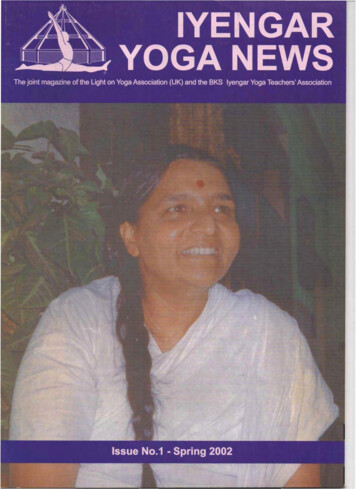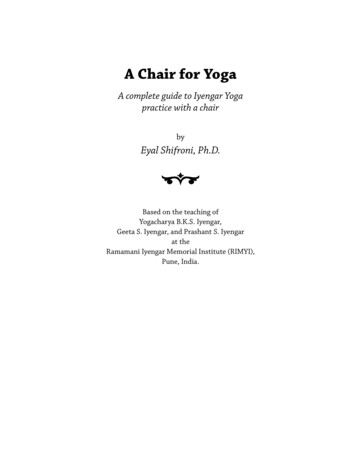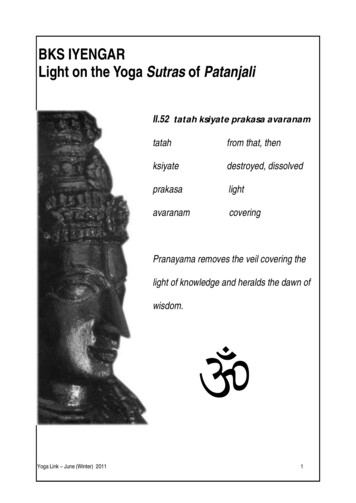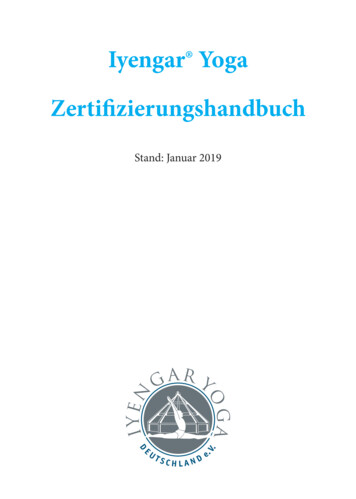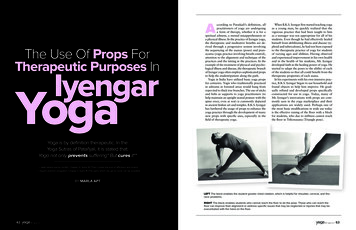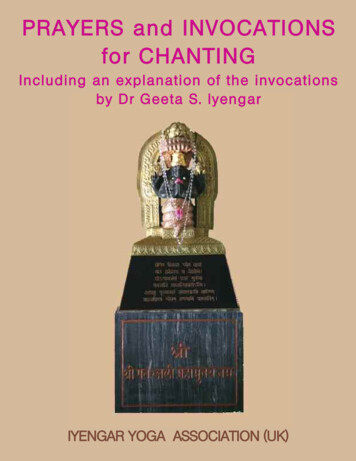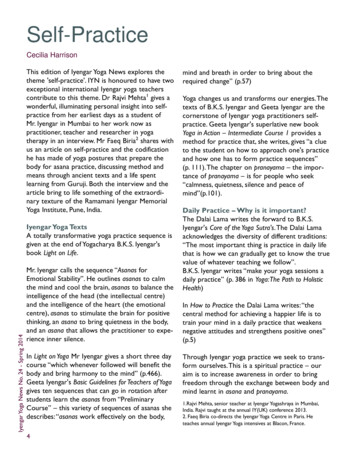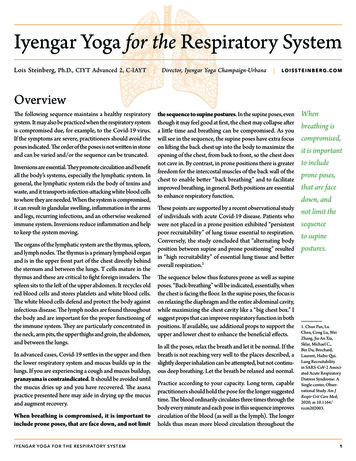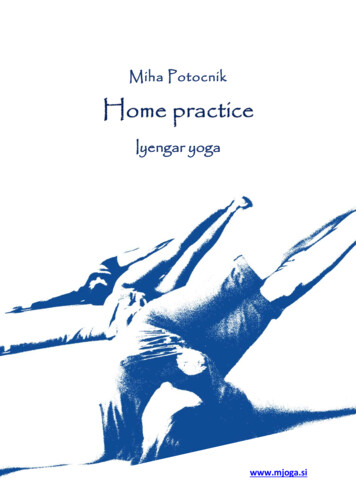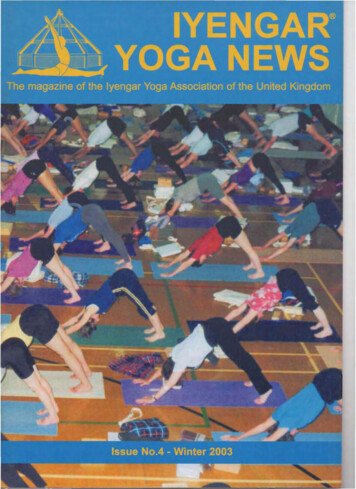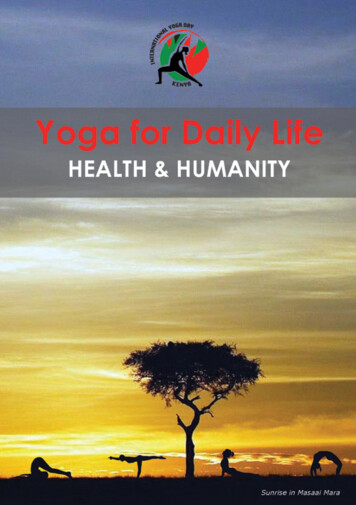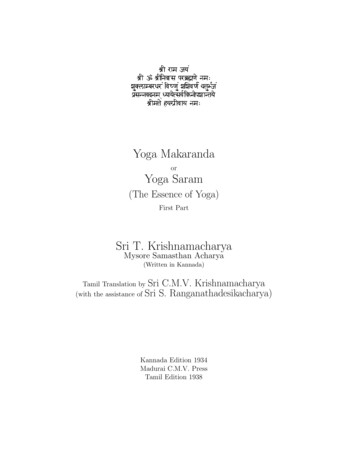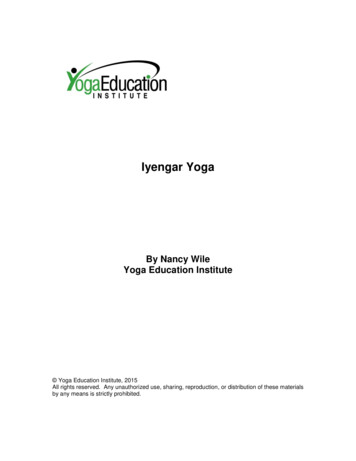
Transcription
Iyengar YogaBy Nancy WileYoga Education Institute Yoga Education Institute, 2015All rights reserved. Any unauthorized use, sharing, reproduction, or distribution of these materialsby any means is strictly prohibited.
Table of Contents:Background of Iyengar Yoga .2Founder and Important Practitioners .2What Make Iyengar Yoga Different 4Overall Areas of Focus in Iyengar Yoga 6Examples of Postures and Teaching Techniques in Iyengar Yoga 9Sample Iyengar Sequences .11Sun Salutations for Iyengar Students .21Use of Props in Iyengar Yoga 22Create Your Own Sequence of Postures Using Props .35Important Literature for Iyengar Yoga .361
Background of Iyengar YogaIyengar Yoga, founded by BKS Iyengar, is a form of hatha yoga that emphasizesprecision and detail of alignment during the practice of asanas and pranayama.It consists of approximately 200 classical yoga postures and 14 styles ofpranayama; ranging from easy to extremely difficult. These asanas have beenstructured and categorized such that they allow a beginner to progress thoroughthe practice safely, while gaining flexibility, strength and a control on their mind.Iyengar yoga focuses on the structural alignment of the physical body throughthe practice of asanas, and aims to unite the body, mind and spirit for health andwell-being. Iyengar differs from the other styles of hatha yoga by four keyelements: technique, sequence, timing, and the use of props.Iyengar Yoga is characterized by great attention to detail and precise focuson body alignment. Iyengar pioneered the use of "props" such as bolsters,benches, blocks, straps and sand bags, which function as aids allowingbeginners to experience asanas more easily and fully than might otherwise bepossible without several years of practice. Props also allow elderly, injured, tiredor ill students to enjoy the benefits of many asanas via fully "supported" methodsrequiring less muscular effort.Unlike more experiential approaches where students are encouraged toindependently "find their way" to their own full expression of an asana, anIyengar Yoga class is highly verbal and precise, with misalignments and errorsactively corrected. Iyengar teachers complete at least two years of rigoroustraining for the introductory certificate. They may complete subsequentintermediate levels and senior levels of certification, potentially entailing adecade or more of training.Founder and Important PractitionersB.K.S. Iyengar was born into a poor family in India. He was the 11th of 13children (10 of whom survived) of father Sri Krishnamachar, a school teacher,and mother Sheshamma. Iyengar's home village of Bellur, was in the grip ofthe influenza pandemic at the time of his birth, leaving him sickly and weak.Throughout his childhood, he struggled with malaria, tuberculosis, typhoid fever,and general malnutrition. When he was five years old his family movedto Bangalore, and within four years his father died of appendicitis.In 1934, Iyengar’s brother-in-law, Sri Tirumalai Krishnamacharya, asked the 15year-old Iyengar to come to Mysore, so as to improve his health through yogapractice. There, Iyengar learned asana practice, which steadily improved hishealth. Krishnamacharya had Iyengar and other students give yogademonstration in the Maharaja's court at Mysore. Iyengar considered hisassociation with his brother-in-law a turning point in his life. Although2
Krishnamacharya only taught for a few weeks over a two-year period, Iyengarhad said that those days determined what he would become. In 1937,Krishnamacharya sent Iyengar to Pune at the age of eighteen to spread theteaching of yoga. He spent many hours each day learning and experimentingwith various techniques.In 1952, Iyengar befriended the violinist Yehudi Menuhin. Practicing yoga underthe guidance of Iyengar helped Menuhin improve his violin playing, and heinvited Iyengar to Switzerland to teach a group there. From then on, Iyengarbegan to regularly visit the west and more and more yoga schools beganteaching his system of yoga practice. Iyengar made his first visit to the UnitedStates in 1956, when he taught in Ann Arbor, Michigan and gave several lecturedemonstrations.In 1966, Light on Yoga was published. It eventually became an internationalbest-seller and has been translated into 17 languages and sold three millioncopies. Light on Yoga was followed by titles on pranayama and various aspectsof yoga philosophy. In total, Iyengar has authored 14 books.In 1975, Iyengar opened the Ramamani Iyengar Memorial Yoga Institute in Pune,in memory of his late wife. He officially retired from teaching in 1984, butcontinued to be active in the world of Iyengar Yoga, teaching special classes,giving lectures, and writing books. Iyengar's daughter, Geeta, and son, Prashant,have gained international acclaim as teachers.Anthropologist Joseph S. Alter of the University of Pittsburgh stated that Iyengar"has by far had the most profound impact on the global spread of yoga."Iyengar attracted his students by offering them just what they sought – whichtended to be physical stamina and flexibility. He conducted demonstrations andlater, when a scooter accident dislocated his spine, began exploring the use ofprops to help disabled people practice Yoga.Iyengar died on August 20, 2014 in Pune, India from heart failure at age 95I think one of his main contributions was making yoga accessible, but also thedegree of attention he gave to the practices of asana and to pranayama wasimmense. He was also an amazing communicator. He was constantly findingnew ways to help his students increase their capacity to be aware of what wasgoing on in their bodies and minds. Iyengar is a lot of the yoga peopleexperience in the United States. The teacher may not be teaching Iyengar, butthat teacher has been influenced by Iyengar yoga in some way. Finally, as afather of six, Iyengar always emphasized the importance of maintaining yourcommitments to family or society, while also maintaining your yoga practice, andnot allowing one to completely take over the other.3
What Makes Iyengar Yoga DifferentOne of the main aspects that distinguishes Iyengar yoga from other forms is thevery high degree of attention paid to alignment. Props may be used to increaseawareness and to make the poses accessible. Poses are often held longer thanstudents might be used to in a flow-style class. The diversity of practice isanother distinguishing element, as is Iyengar’s therapeutic approach to yoga.Focus on AlignmentAlthough most forms of hatha yoga focus on proper alignment, Iyengar yoga putsproper alignment at the top of importance. Alignment refers to your body’srelationship with gravity. Gravity is pushing down on us all of the time. We don’tnotice it because it is happening all of the time. But your body is dealing withgravity right now. If you lean your body to one side, just about 2 or 3 inches, andhold that position, you will start to get tired. If you consciously sit up straight youwill feel a bit lighter. It’s no mystery. When the body is in good alignment, you feellighter. When it is out of alignment you feel heavier. If you stand a pole on its endand align it perfectly, gravity’s pressure will hold it up; if the alignment is poor, itwill fall. The same is true in the body.Alignment, in the smaller picture, refers to your body in relation to itself. If youlean your body to one side, just about 2 or 3 inches, and hold that position again,you can feel the muscles on the side you lean away from begin to tense. Thosemuscles are keeping you balanced in the field of gravity. If they didn’t activate atthe same time you lean, gravity would push you to the floor. Nobody has perfectalignment. We all lean a bit to one side more than the other. Some imbalancescome from overuse (use of one side or area in a specific movement that werepeatedly perform at work or sports, or even sleep), some from injuries, whileothers arise from simple misuse of the body. For each imbalance, we also have abalancing mechanism, something that responds to the imbalance to keep us fromfalling over. These are called compensations. If one shoulder is pulled in to theneck more than the other, the ribs will have to compensate. When the ribs shift,the pelvis twists, and then the foot turns. Although the body is balanced, it is acompromised balance, a state where many of the muscles and joints areconstantly working against a subtle (or not so subtle) lean, or twist.Iyengar yoga believes that when we practice the asanas with the intention tobring the body into greater alignment, we address the imbalances andcompensations in the body. We address the compromised balance that the bodyis used to dealing with, and change it to an intelligent balance; one that workswith gravity rather than against it.Detailed InstructionThe instruction and set up for each posture is more detailed and complex than inmany other forms of hatha yoga. The alignment and action of each part of the4
body is analyzed in each posture. Iyengar focuses on proper alignment in aposture of both the main joints, limbs and body parts involved, as well as thoseparts of the body that may be forgotten in a particular pose.Postures Held LongerStudents also hold the asanas for a longer period of time than in other forms ofyoga. This is because yoga Iyengar believed that if a student holds thesepostures for a longer period of time, it helped the body achievethe asana’s benefits completely, allowing its effects to penetrate deeper in to thebody. Apart from that, according to the principles of Iyengar yoga, when a persongets into an asana it takes the body some time to acclimate and become stablein that posture. After that, the person can focus on their breathing and allow theirbody to benefit from the asana. Postures cannot be done swiftly or withoutawareness. It takes time to move into a posture and become stable. When thishas been achieved, it then takes some time to intensify the depth of the postureand so extract its benefit. Otherwise the potential effects and benefits remainsmall compared to what is possible.Practice of Pranayama Comes LaterPranayama comes only after a student has mastered the asanas: In most otherforms of yoga a person can perform pranayama (deep breathing techniques) assoon as they start practicing the asanas, but Iyengar yoga emphasizes that astudent should perform pranayama only after they have mastered the asanas.This is because while performing an asana a person is taught to fine-tune themovements of their body. They are taught to discipline their body, make it moreflexible and better aligned. At the same time they learn to breathe correctly andto focus on even the smallest parts of their body; helping them intensify theirmeditative state while performing asanas. This also allows the flow of life energyor prana without any blocks, which is how pranayama essentially benefits theentire body. Moreover, if a person practices asanas properly they will also beable to be more aware of their entire body making their mind more sharp andattentive. Once they have mastered all these techniques, they may startpracticing pranayama as it is not simply a form of deep breathing but requiresone to sit in a posture for a long period of time, reign in their mind and breath inand out with the correct technique to gain it’s full benefits – for which a person’sbody and mind has to be ready.Use of PropsIyengar yoga emphasizes the correct alignment of all parts of the body whileperforming an asana. In order to facilitate this, he developed several props likethe yoga block, chairs, blankets and belts that can aid a person in performingasanas. Today, these props are common in many forms of hatha yoga, butthese props were first introduced in Iyengar yoga. Props help a person adjustand support themselves so that they can practice the asana with correctalignment in a way that is safe and effective.5
Much Variation in the Sequences UsedIn Iyengar, there is an emphasis on changing the sequences every day. Thesequences of the asanas in Iyengar yoga can be very different each practice.Even though some of the postures may be repeated, it encourages teachers todrastically change the sequencing of those postures from one day to the next.Iyengar yoga believes that this diversity in the practice helps to prevent injury andoveruse, and engages both the mind and body in the practice. According to theprinciples of Iyengar yoga, by varying the sequence in which postures arepracticed, the effect of the asana (both mental and physical) can be intensified.Iyengar also believed that this alteration helped bring about a change in thewhole person, including his/her spiritual evolution.Inversions are ImportantHeadstand and shoulder stand are really important poses in Iyengar practice.They are not always taught in other styles of yoga. Iyengar yoga offersalternatives for people who are not able to do them. If someone comes to anIyengar class, they know there will be some inverted pose that is taught.Inversions are often made more accessible to students through the use of props,such as a yoga blanket to prevent overstretching of the neck area.Cautious and MindfulIyengar yoga is very cautious and mindful. The use of props helps create a safeand supported practice, as does the slow pace. Iyengar emphasizes the need tokeep students safe and to protect the joints.Importance of Learning with a GuruIn Iyengar, and emphasis is placed on gurus and knowledgeable teachers.Iyengar yoga describes a guru as someone who is free from ego and who leadtheir student through a spiritual path. It is believed that a guru can help elimateobstacles to the student’s practice and that a guru is essential to learningpostures and pranayama correctly.Specifics of Practice in Iyengar YogaFor physical practices of asanas, Iyengar yoga emphasizes that first the ya
Iyengar yoga focuses on the structural alignment of the physical body through the practice of asanas, and aims to unite the body, mind and spirit for health and well-being. Iyengar differs from the other styles of hatha yoga by four key elements: technique, sequence, timing, and the use of props. Iyengar Yoga is characterized by great attention to detail and precise focus on body alignment .
